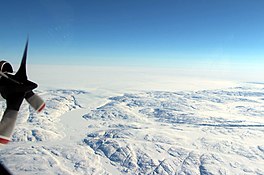| Hiawatha Glacier | |
|---|---|
 Land-terminating Hiawatha Glacier (left-center) emerging from its semicircular parent ice lobe, in NW Greenland Land-terminating Hiawatha Glacier (left-center) emerging from its semicircular parent ice lobe, in NW Greenland | |
| Coordinates | 78°49′N 67°01′W / 78.817°N 67.017°W / 78.817; -67.017 |
Hiawatha Glacier is a glacier in northwest Greenland, with its terminus in Inglefield Land. It was mapped in 1922 by Lauge Koch, who noted that the glacier tongue extended into Lake Alida (near Foulk Fjord). Hiawatha Glacier attracted attention in 2018 because of the discovery of a crater beneath the surface of the ice sheet in the area. A publication noted in 1952 that Hiawatha Glacier had been retreating since 1920.
Probable impact structure
Main article: Hiawatha impact structure
The proposed impact structure was identified using airborne radar surveys that showed the presence of a 31 km wide crater-like depression in the bedrock beneath the ice. Shocked quartz grains and melt rock clasts have been found in fluvio-glacial sediments deposited by a river that drains the area of the structure. The timing of the impact has been dated using argon-argon dating and uranium-lead dating of zircon crystals within the melt rock to 57.99 ± 0.54 million years ago, during the late Paleocene.
From an interpretation of the crystalline nature of the underlying rock, together with chemical analysis of sediment washed from the crater, the impactor was argued to be a type of iron asteroid with a diameter in the order of 1.5 kilometres (0.9 mi). If an impact origin for the crater is confirmed, it would be one of the twenty-five largest known impact craters on Earth.
See also
References
- Dawes; et al. (2000). "Kane Basin 1999: mapping, stratigraphic studies and economic assessment of Precambrian and Lower Palaeozoic provinces in north-western Greenland". p. 11.
- "Hiawatha Gletscher: Greenland". Geographical Names. Retrieved November 15, 2018.
- Davies, William E.; Krinsley, Daniel B. (1962). "The recent regimen of the ice cap margin in North Greenland" (PDF). International Association of Scientific Hydrology, Commission of Snow and Ice. p. 124. Archived from the original (PDF) on 2021-06-25. Retrieved 2018-11-16.
- St. Fleur, Niocholas (November 14, 2018). "Ice Age Asteroid Crater Discovered Beneath Greenland Glacier - It is the first crater discovered under one of Earth's ice sheets, according to the scientists who found it". The New York Times. Retrieved November 18, 2018.
- Børge Fristrup (1952). "Die Klimaänderungen in der Arktis und ihre Bedeutung besonders für Grönland". Erdkunde. 6 (4). doi:10.3112/erdkunde.1952.04.01.
- ^ Kjær, Kurt H.; et al. (November 2018). "A large impact crater beneath Hiawatha Glacier in northwest Greenland". Science Advances. 4 (11): eaar8173. Bibcode:2018SciA....4.8173K. doi:10.1126/sciadv.aar8173. PMC 6235527. PMID 30443592.
- Kenny, G.G.; Hyde, W.R.; Storey, M.; Garde, A.A.; Whitehouse, M.J.; Beck, P.; Johansson, L.; Søndergaard, A.S.; Bjørk, A.A.; MacGregor, J.A.; Khan, S.A.; Mouginot, J.; Johnson, B.C.; Silber, E.A.; Wielandt, D.K.P.; Kjær, K.H.; Larsen, N.K. (11 March 2022). "A Late Paleocene age for Greenland's Hiawatha impact structure". Science Advances. 8 (10): eabm2434. doi:10.1126/sciadv.abm2434. PMC 8906741. PMID 35263140.
External links
[REDACTED] Scholia has a profile for Hiawatha Glacier (Q24842587). [REDACTED] Scholia has a profile for Hiawatha impact crater (Q58675331).- International Team, NASA Make Unexpected Discovery Under Greenland Ice NASA/Video
- Massive crater under Greenland's ice points to climate-altering impact in the time of humans Video
- Discovering a massive meteorite crater Docu/Video